CUDA之通用矩陣乘法:從入門到熟練!
- 王林轉載
- 2024-03-25 12:30:271361瀏覽
通用矩陣乘法(General Matrix Multiplication,GEMM)是許多應用程式和演算法中至關重要的一部分,也是評估電腦硬體效能的重要指標之一。透過深入研究和優化GEMM的實現,可以幫助我們更好地理解高效能運算以及軟硬體系統之間的關係。在電腦科學中,對GEMM進行有效的最佳化可以提高運算速度並節省資源,這對於提高電腦系統的整體效能至關重要。深入了解GEMM的工作原理和最佳化方法,有助於我們更好地利用現代計算硬體的潛力,並為各種複雜計算任務提供更有效率的解決方案。透過GEMM效能的最佳化與改進,可以加上
一、GEMM的基本特徵
1.1 GEMM計算過程及複雜度
#GEMM 的定義為:



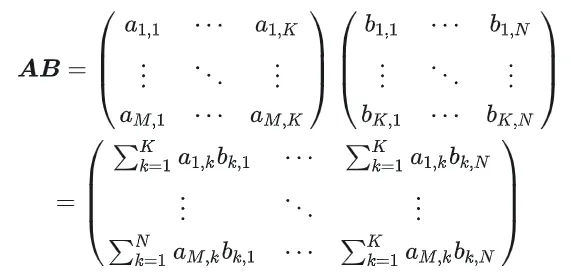




1.2 簡單實作及過程分析
#define OFFSET(row, col, ld) ((row) * (ld) + (col))void cpuSgemm(float *a, float *b, float *c, const int M, const int N, const int K) {for (int m = 0; m <p></p>#下面使用CUDA實現最簡單的矩陣乘法的Kernal,一共使用M * N 個執行緒完成整個矩陣乘法。每個執行緒負責矩陣C中一個元素的計算,需要完成K次乘累加。矩陣A,B,C皆存放與全域記憶體中(由修飾符<div> </div>###__global__###### ###確定),完整程式碼請見 sgemm_naive.cu 。 ######<pre class="brush:php;toolbar:false">__global__ void naiveSgemm(float * __restrict__ a, float * __restrict__ b, float * __restrict__ c,const int M, const int N, const int K) {int n = blockIdx.x * blockDim.x + threadIdx.x;int m = blockIdx.y * blockDim.y + threadIdx.y;if (m ######編譯完成,在Tesla V100-PCIE-32GB上執行的結果如下,根據V100的白皮書,FP32 的峰值算力為15.7 TFLOPS,因此該方式算力利用率僅有11.5%。 ######<pre class="brush:php;toolbar:false">M N K =128128 1024, Time = 0.00010083 0.00010260 0.00010874 s, AVG Performance = 304.5951 GflopsM N K =192192 1024, Time = 0.00010173 0.00010198 0.00010253 s, AVG Performance = 689.4680 GflopsM N K =256256 1024, Time = 0.00010266 0.00010318 0.00010384 s, AVG Performance =1211.4281 GflopsM N K =384384 1024, Time = 0.00019475 0.00019535 0.00019594 s, AVG Performance =1439.7206 GflopsM N K =512512 1024, Time = 0.00037693 0.00037794 0.00037850 s, AVG Performance =1322.9753 GflopsM N K =768768 1024, Time = 0.00075238 0.00075558 0.00075776 s, AVG Performance =1488.9271 GflopsM N K = 1024 1024 1024, Time = 0.00121562 0.00121669 0.00121789 s, AVG Performance =1643.8068 GflopsM N K = 1536 1536 1024, Time = 0.00273072 0.00275611 0.00280208 s, AVG Performance =1632.7386 GflopsM N K = 2048 2048 1024, Time = 0.00487622 0.00488028 0.00488614 s, AVG Performance =1639.2518 GflopsM N K = 3072 3072 1024, Time = 0.01001603 0.01071136 0.01099990 s, AVG Performance =1680.4589 GflopsM N K = 4096 4096 1024, Time = 0.01771046 0.01792170 0.01803462 s, AVG Performance =1785.5450 GflopsM N K = 6144 6144 1024, Time = 0.03988969 0.03993405 0.04000595 s, AVG Performance =1802.9724 GflopsM N K = 8192 8192 1024, Time = 0.07119219 0.07139694 0.07160816 s, AVG Performance =1792.7940 GflopsM N K =1228812288 1024, Time = 0.15978026 0.15993242 0.16043369 s, AVG Performance =1800.7606 GflopsM N K =1638416384 1024, Time = 0.28559187 0.28567238 0.28573316 s, AVG Performance =1792.2629 Gflops###下面以M=512,K=512,N=512,為例,詳細分析一下上述計算過程的workflow:
- 在Global Memory 中分別為矩陣A,B,C分配儲存空間.
- 由於矩陣C中每個元素的計算均相互獨立, 因此在並行度映射中讓每個thread 對應矩陣C中1 個元素的計算.
- 執行配置(execution configuration)中gridSize 和blockSize 都有x(列向)、y(行向)兩個維度, 其中


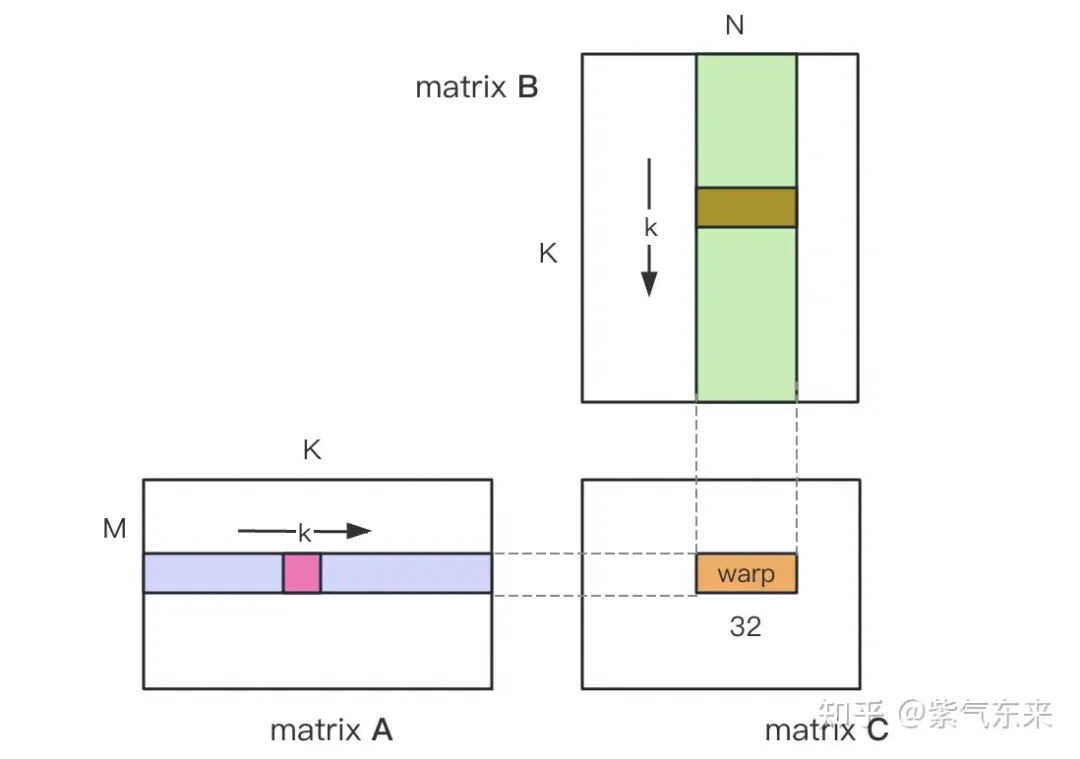


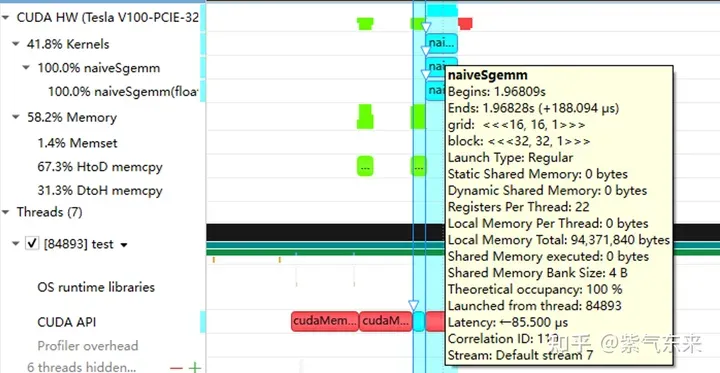
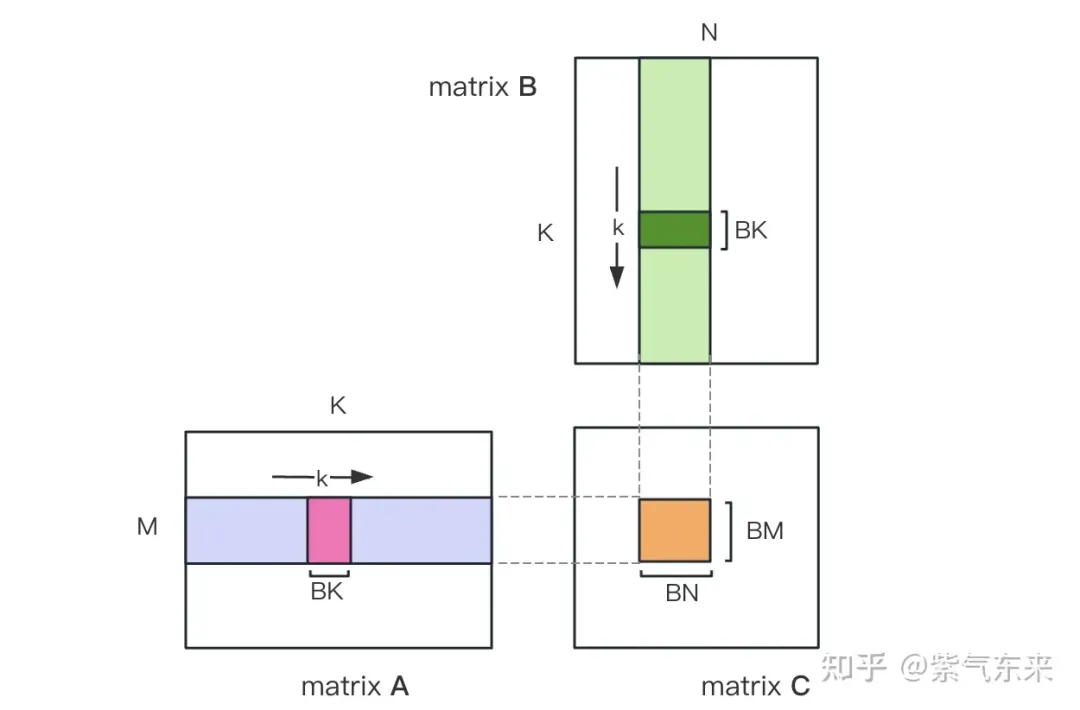
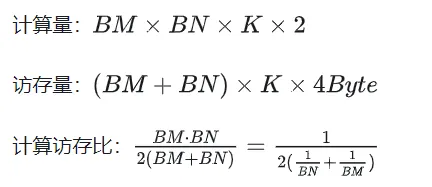
TM和TN的取值也受到兩方面限制,一方面是線程數的限制,一個Block中有BM / TM * BN / TN個線程,這個數字不能超過1024,且不能太高防止影響SM內Block間的平行;另一方面是暫存器數目的限制,一個執行緒至少需要TM * TN個暫存器來存放矩陣C的部分和,再加上一些其它的暫存器,所有的暫存器數目不能超過256,且不能太高防止影響SM內同時並行的執行緒數目。
最終選取 BM = BN = 128,BK = 8,TM = TN = 8,則此時計算訪存比為32。根據V100的理論算力15.7TFLOPS,可得 15.7TFLOPS/32 = 490GB/s,根據實測的HBM頻寬為763GB/s,可知此時頻寬不再會限制運算效能。
根據上述分析,kernel 函數實作過程如下,完整程式碼參考sgemm_v1.cu,主要步驟包括:



A B 矩陣分塊的執行緒索引關係
確定好單一block的執行過程,接下來需要確定多block處理的不同分塊在Global Memory中的對應關係,仍以A為例進行說明。由於分塊沿著行的方向移動,那麼首先需要確定行號,根據Grid 的二維全域線性索引關係,by * BM 表示該分塊的起始行號,同時我們已知load_a_smem_m 為分塊內部的行號,因此全域的行號為load_a_gmem_m = by * BM load_a_smem_m ## ## ## ## ## ## ## ## ## ## ## 。由於分塊沿著行的方向移動,因此列是變化的,需要在循環內部計算,同樣也是先計算起始列號bk * BK 加速分塊內部列號load_a_smem_k
 得到
得到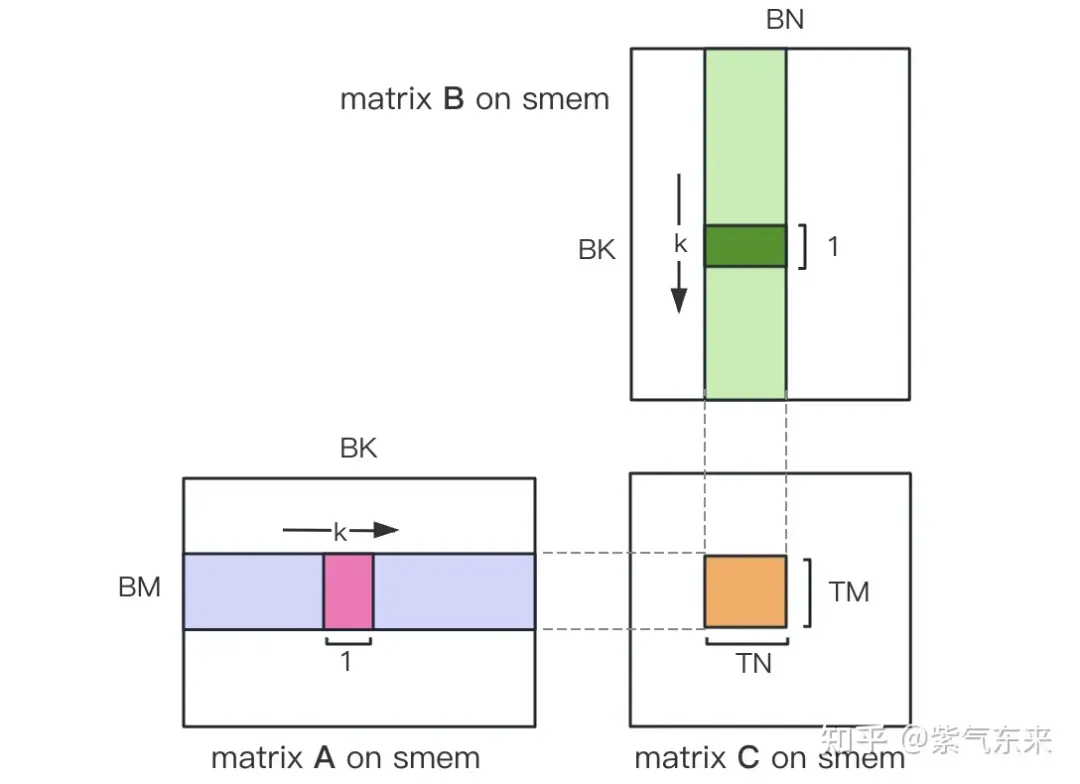
計算完後,還需要將其存入 Global Memory 中,這需要計算其在 Global Memory 中的對應關係。由於存在較小的分塊,則行和列都由3部分構成:全域行號store_c_gmem_m 等於大分塊的起始行號by * BM 小分塊的起始行號ty * TM 小分塊內部的相對行號 i 。列同理。
__global__ void sgemm_V1(float * __restrict__ a, float * __restrict__ b, float * __restrict__ c,const int M, const int N, const int K) {const int BM = 128;const int BN = 128;const int BK = 8;const int TM = 8;const int TN = 8;const int bx = blockIdx.x;const int by = blockIdx.y;const int tx = threadIdx.x;const int ty = threadIdx.y;const int tid = ty * blockDim.x + tx;__shared__ float s_a[BM][BK];__shared__ float s_b[BK][BN];float r_c[TM][TN] = {0.0};int load_a_smem_m = tid >> 1;// tid/2, row of s_aint load_a_smem_k = (tid & 1) > 5; // tid/32, row of s_bint load_b_smem_n = (tid & 31) 計算結果如下,效能達到了理論峰值效能的51.7%:
M N K =128128 1024, Time = 0.00031578 0.00031727 0.00032288 s, AVG Performance =98.4974 GflopsM N K =192192 1024, Time = 0.00031638 0.00031720 0.00031754 s, AVG Performance = 221.6661 GflopsM N K =256256 1024, Time = 0.00031488 0.00031532 0.00031606 s, AVG Performance = 396.4287 GflopsM N K =384384 1024, Time = 0.00031686 0.00031814 0.00032080 s, AVG Performance = 884.0425 GflopsM N K =512512 1024, Time = 0.00031814 0.00032007 0.00032493 s, AVG Performance =1562.1563 GflopsM N K =768768 1024, Time = 0.00032397 0.00034419 0.00034848 s, AVG Performance =3268.5245 GflopsM N K = 1024 1024 1024, Time = 0.00034570 0.00034792 0.00035331 s, AVG Performance =5748.3952 GflopsM N K = 1536 1536 1024, Time = 0.00068797 0.00068983 0.00069094 s, AVG Performance =6523.3424 GflopsM N K = 2048 2048 1024, Time = 0.00136173 0.00136552 0.00136899 s, AVG Performance =5858.5604 GflopsM N K = 3072 3072 1024, Time = 0.00271910 0.00273115 0.00274006 s, AVG Performance =6590.6331 GflopsM N K = 4096 4096 1024, Time = 0.00443805 0.00445964 0.00446883 s, AVG Performance =7175.4698 GflopsM N K = 6144 6144 1024, Time = 0.00917891 0.00950608 0.00996963 s, AVG Performance =7574.0999 GflopsM N K = 8192 8192 1024, Time = 0.01628838 0.01645271 0.01660790 s, AVG Performance =7779.8733 GflopsM N K =1228812288 1024, Time = 0.03592557 0.03597434 0.03614323 s, AVG Performance =8005.7066 GflopsM N K =1638416384 1024, Time = 0.06304122 0.06306373 0.06309302 s, AVG Performance =8118.7715 Gflops
下面仍以M=512,K=512,N=512為例,分析一下結果。首先透過 profiling 可以看到 Shared Memory 佔用為 8192 bytes,這與理論上(128 128)X8X4完全一致。
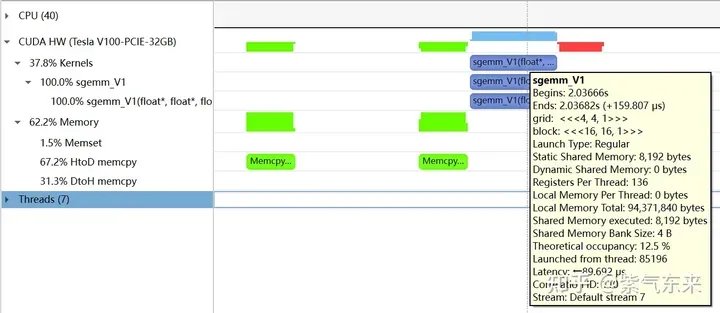 nsys 記錄的V1 版本的profiling
nsys 記錄的V1 版本的profiling
profiling 顯示Occupancy 為12.5%,可以透過cuda-calculator 加以印證,該例中threads per block = 256, Registers per thread = 136, 由此可以計算得到每個SM中活躍的warp 為8,而對於V100,每個SM中的warp 總數為64,因此Occupancy 為8/64 = 12.5%。

2.2 解決Bank Conflict 問題
上節透過利用Shared Memory 大幅提高了訪存效率,進而提高了效能,本節將進一步優化Shared Memory 的使用。
Shared Memory共分為32個Bank,每個Bank的寬度為4 Bytes,如果需要存取同一個Bank的多個數據,就會發生Bank Conflict。例如一個Warp的32個線程,如果訪問的地址分別為0、4、8、...、124,就不會發生Bank Conflict,只佔用Shared Memory一拍的時間;如果訪問的地址為0、8 、16、...、248,這樣一來地址0和地址128對應的資料位於同一Bank、地址4和地址132對應的資料位於同一Bank,以此類推,那麼就需要佔用Shared Memory兩拍的時間才能讀出。

有Bank Conflict VS 無Bank Conflict
再看V1 版本計算部分的三層循環,每次從Shared memory中取矩陣A的長度為TM的向量和矩陣B的長度為TN的向量,這兩個向量做外積並累加到部分和中,一次外積共TM * TN次乘累加,一共需要循環BK次取數和外積。
接下來分析從Shared Memory load的過程中存在的Bank Conflict:
i) 取矩陣A需要取一個列向量,而矩陣A在Shared Memory中是按行儲存的;
ii) 在TM = TN = 8的情況下,無論矩陣A或矩陣B,從Shared Memory中取數時需要取連續的8個數,即便用LDS.128指令一條指令取四個數,也需要兩個指令,由於一個執行緒的兩個load指令的位址是連續的,那麼同一個Warp不同執行緒的同一個load指令的訪存位址就是被間隔開的,便存在著Bank Conflict 。
為了解決上述的兩點Shared Memory的Bank Conflict,採用了一下兩點優化:
i) 為矩陣A分配Shared Memory時形狀分配為[BK][BM],即讓矩陣A在Shared Memory中按列儲存
ii) 將原本每個執行緒負責計算的TM * TN的矩陣C,分成下圖中這樣的兩塊TM/2 * TN的矩陣C,由於TM/2=4,一條指令即可完成A的一塊的load操作,兩個load可同時進行。

kernel 函數的核心部分實作如下,完整程式碼見 sgemm_v2.cu 。
__shared__ float s_a[BK][BM];__shared__ float s_b[BK][BN];float r_load_a[4];float r_load_b[4];float r_comp_a[TM];float r_comp_b[TN];float r_c[TM][TN] = {0.0};int load_a_smem_m = tid >> 1;int load_a_smem_k = (tid & 1) > 5;int load_b_smem_n = (tid & 31) 結果如下,相對未解 Bank Conflict 版(V1) 效能提高了 14.4%,達到了理論高峰的74.3%。
M N K =128128 1024, Time = 0.00029699 0.00029918 0.00030989 s, AVG Performance = 104.4530 GflopsM N K =192192 1024, Time = 0.00029776 0.00029828 0.00029882 s, AVG Performance = 235.7252 GflopsM N K =256256 1024, Time = 0.00029485 0.00029530 0.00029619 s, AVG Performance = 423.2949 GflopsM N K =384384 1024, Time = 0.00029734 0.00029848 0.00030090 s, AVG Performance = 942.2843 GflopsM N K =512512 1024, Time = 0.00029853 0.00029945 0.00030070 s, AVG Performance =1669.7479 GflopsM N K =768768 1024, Time = 0.00030458 0.00032467 0.00032790 s, AVG Performance =3465.1038 GflopsM N K = 1024 1024 1024, Time = 0.00032406 0.00032494 0.00032621 s, AVG Performance =6155.0281 GflopsM N K = 1536 1536 1024, Time = 0.00047990 0.00048224 0.00048461 s, AVG Performance =9331.3912 GflopsM N K = 2048 2048 1024, Time = 0.00094426 0.00094636 0.00094992 s, AVG Performance =8453.4569 GflopsM N K = 3072 3072 1024, Time = 0.00187866 0.00188096 0.00188538 s, AVG Performance =9569.5816 GflopsM N K = 4096 4096 1024, Time = 0.00312589 0.00319050 0.00328147 s, AVG Performance = 10029.7885 GflopsM N K = 6144 6144 1024, Time = 0.00641280 0.00658940 0.00703498 s, AVG Performance = 10926.6372 GflopsM N K = 8192 8192 1024, Time = 0.01101130 0.01116194 0.01122950 s, AVG Performance = 11467.5446 GflopsM N K =1228812288 1024, Time = 0.02464854 0.02466705 0.02469344 s, AVG Performance = 11675.4946 GflopsM N K =1638416384 1024, Time = 0.04385955 0.04387468 0.04388355 s, AVG Performance = 11669.5995 Gflops
分析一下profiling 可以看到Static Shared Memory 仍然是使用了8192 Bytes,奇怪的是,Shared Memory executed 卻翻倍變成了16384 Bytes(知友如果知道原因可以告訴我一下)。

2.3 流水並行化:Double Buffering
Double Buffering,即雙重緩衝,即透過增加buffer的方式,使得 存取-計算 的序列模式管線化,以減少等待時間,提高運算效率,其原理如下圖所示:
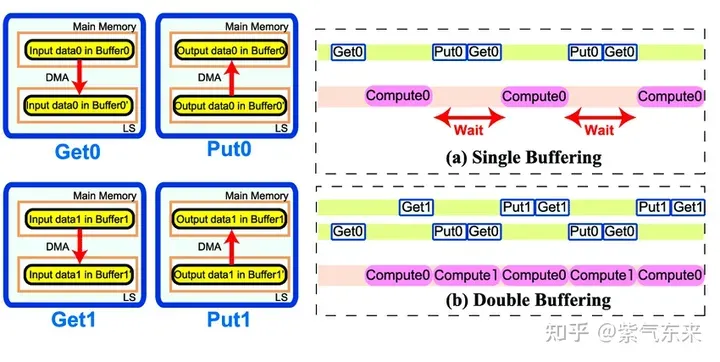
Single Buffering VS Double Buffering
具體到GEMM 任務中來,就是需要兩倍的Shared Memory,之前只需要BK * (BM BN) * 4 Bytes的Shared Memory ,採用Double Buffering之後需要2BK * (BM BN) * 4 Bytes的Shared Memory,然後使其pipeline 流動。
程式碼核心部分如下所示,完整程式碼請參考 sgemm_v3.cu 。有以下幾點要注意:
1)主循環從bk = 1 開始,第一次資料載入在主循環之前,最後一次計算在主循環之後,這是pipeline 的特點決定的;
2)由於計算和下一次訪問使用的Shared Memory不同,因此主循環中每次循環只需要一次__syncthreads()即可
3)由於GPU無法向CPU那樣支援亂序執行,主循環中需要先將下一次迴圈運算所需的Gloabal Memory中的資料load 到暫存器,然後進行本次計算,之後再將load到暫存器中的資料寫到Shared Memory,這樣在LDG指令向Global Memory做load時,不會影響後續FFMA及其它運算指令的launch 執行,也就達到了Double Buffering的目的。
__shared__ float s_a[2][BK][BM];__shared__ float s_b[2][BK][BN];float r_load_a[4];float r_load_b[4];float r_comp_a[TM];float r_comp_b[TN];float r_c[TM][TN] = {0.0};int load_a_smem_m = tid >> 1;int load_a_smem_k = (tid & 1) > 5;int load_b_smem_n = (tid & 31) 效能如下所示,達到了理論高峰的 80.6%。
M N K =128128 1024, Time = 0.00024000 0.00024240 0.00025792 s, AVG Performance = 128.9191 GflopsM N K =192192 1024, Time = 0.00024000 0.00024048 0.00024125 s, AVG Performance = 292.3840 GflopsM N K =256256 1024, Time = 0.00024029 0.00024114 0.00024272 s, AVG Performance = 518.3728 GflopsM N K =384384 1024, Time = 0.00024070 0.00024145 0.00024198 s, AVG Performance =1164.8394 GflopsM N K =512512 1024, Time = 0.00024173 0.00024237 0.00024477 s, AVG Performance =2062.9786 GflopsM N K =768768 1024, Time = 0.00024291 0.00024540 0.00026010 s, AVG Performance =4584.3820 GflopsM N K = 1024 1024 1024, Time = 0.00024534 0.00024631 0.00024941 s, AVG Performance =8119.7302 GflopsM N K = 1536 1536 1024, Time = 0.00045712 0.00045780 0.00045872 s, AVG Performance =9829.5167 GflopsM N K = 2048 2048 1024, Time = 0.00089632 0.00089970 0.00090656 s, AVG Performance =8891.8924 GflopsM N K = 3072 3072 1024, Time = 0.00177891 0.00178289 0.00178592 s, AVG Performance = 10095.9883 GflopsM N K = 4096 4096 1024, Time = 0.00309763 0.00310057 0.00310451 s, AVG Performance = 10320.6843 GflopsM N K = 6144 6144 1024, Time = 0.00604826 0.00619887 0.00663078 s, AVG Performance = 11615.0253 GflopsM N K = 8192 8192 1024, Time = 0.01031738 0.01045051 0.01048861 s, AVG Performance = 12248.2036 GflopsM N K =1228812288 1024, Time = 0.02283978 0.02285837 0.02298272 s, AVG Performance = 12599.3212 GflopsM N K =1638416384 1024, Time = 0.04043287 0.04044823 0.04046151 s, AVG Performance = 12658.1556 Gflops
從profiling 可以看到雙倍的Shared Memory 的佔用
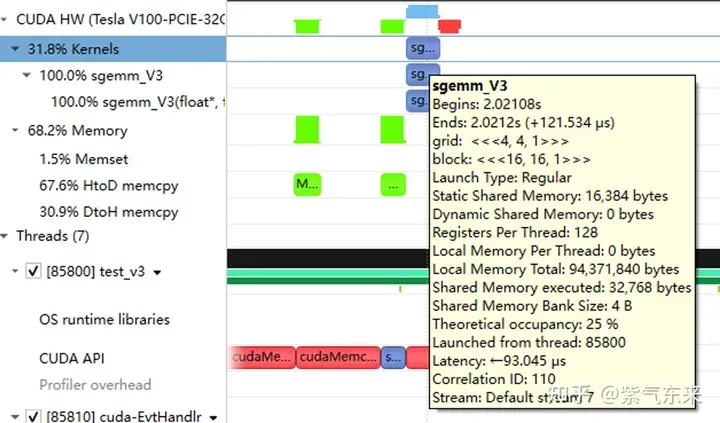
三、cuBLAS 實作方式探究
本節我們將認識CUDA的標準函式庫-cuBLAS,即NVIDIA版本的基本線性代數子程式(Basic Linear Algebra Subprograms, BLAS) 規範實作程式碼。它支援 Level 1 (向量與向量運算) ,Level 2 (向量與矩陣運算) ,Level 3 (矩陣與矩陣運算) 層級的標準矩陣運算。
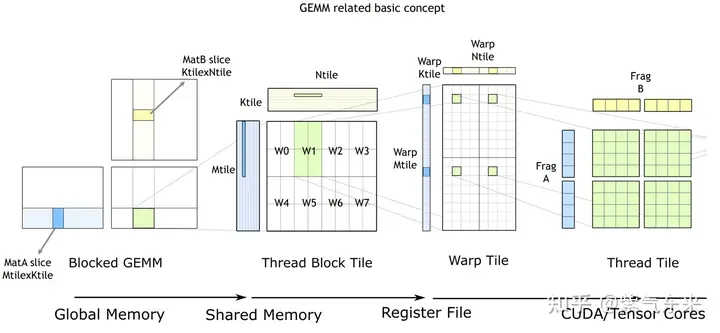
cuBLAS/CUTLASS GEMM的基本過程
#如上圖所示,計算過程分解成線程區塊片(thread block tile )、線程束片(warp tile)和線程片(thread tile)的層次結構並將AMP的策略應用於此層次結構來高效率的完成基於GPU的拆分成tile的GEMM。這個層次結構緊密地反映了NVIDIA CUDA程式設計模型。可以看到從global memory到shared memory的資料移動(矩陣到thread block tile);從shared memory到暫存器的資料移動(thread block tile到warp tile);從暫存器到CUDA core的計算(warp tile到thread tile )。
cuBLAS 實作了單精確度矩陣乘的函數cublasSgemm,其主要參數如下:
cublasStatus_t cublasSgemm( cublasHandle_t handle, // 调用 cuBLAS 库时的句柄 cublasOperation_t transa, // A 矩阵是否需要转置 cublasOperation_t transb, // B 矩阵是否需要转置 int m, // A 的行数 int n, // B 的列数 int k, // A 的列数 const float *alpha, // 系数 α, host or device pointer const float *A, // 矩阵 A 的指针,device pointer int lda, // 矩阵 A 的主维,if A 转置, lda = max(1, k), else max(1, m) const float *B, // 矩阵 B 的指针, device pointer int ldb, // 矩阵 B 的主维,if B 转置, ldb = max(1, n), else max(1, k) const float *beta, // 系数 β, host or device pointer float *C, // 矩阵 C 的指针,device pointer int ldc // 矩阵 C 的主维,ldc >= max(1, m) );
呼叫方式如下:
cublasHandle_t cublas_handle;cublasCreate(&cublas_handle);float cublas_alpha = 1.0;float cublas_beta = 0;cublasSgemm(cublas_handle, CUBLAS_OP_N, CUBLAS_OP_N, N, M, K, &cublas_alpha, d_b, N, d_a, K, &cublas_beta, d_c, N);
性能如下所示,達到了理論峰值的82.4%。
M N K =128128 1024, Time = 0.00002704 0.00003634 0.00010822 s, AVG Performance = 860.0286 GflopsM N K =192192 1024, Time = 0.00003155 0.00003773 0.00007267 s, AVG Performance =1863.6689 GflopsM N K =256256 1024, Time = 0.00003917 0.00004524 0.00007747 s, AVG Performance =2762.9438 GflopsM N K =384384 1024, Time = 0.00005318 0.00005978 0.00009120 s, AVG Performance =4705.0655 GflopsM N K =512512 1024, Time = 0.00008326 0.00010280 0.00013840 s, AVG Performance =4863.9646 GflopsM N K =768768 1024, Time = 0.00014278 0.00014867 0.00018816 s, AVG Performance =7567.1560 GflopsM N K = 1024 1024 1024, Time = 0.00023485 0.00024460 0.00028150 s, AVG Performance =8176.5614 GflopsM N K = 1536 1536 1024, Time = 0.00046474 0.00047607 0.00051181 s, AVG Performance =9452.3201 GflopsM N K = 2048 2048 1024, Time = 0.00077930 0.00087862 0.00092307 s, AVG Performance =9105.2126 GflopsM N K = 3072 3072 1024, Time = 0.00167904 0.00168434 0.00171114 s, AVG Performance = 10686.6837 GflopsM N K = 4096 4096 1024, Time = 0.00289619 0.00291068 0.00295904 s, AVG Performance = 10994.0128 GflopsM N K = 6144 6144 1024, Time = 0.00591766 0.00594586 0.00596915 s, AVG Performance = 12109.2611 GflopsM N K = 8192 8192 1024, Time = 0.01002384 0.01017465 0.01028435 s, AVG Performance = 12580.2896 GflopsM N K =1228812288 1024, Time = 0.02231159 0.02233805 0.02245619 s, AVG Performance = 12892.7969 GflopsM N K =1638416384 1024, Time = 0.03954650 0.03959291 0.03967242 s, AVG Performance = 12931.6086 Gflops
由此可以對比以上各種方法的性能情況,可見手動實現的性能已接近官方的性能,如下:
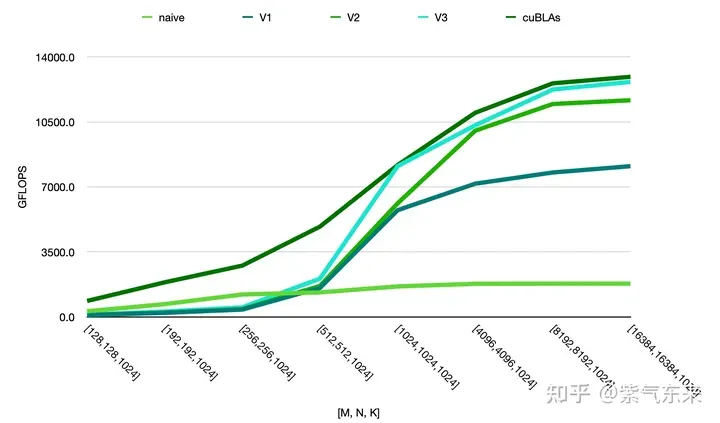
以上是CUDA之通用矩陣乘法:從入門到熟練!的詳細內容。更多資訊請關注PHP中文網其他相關文章!

